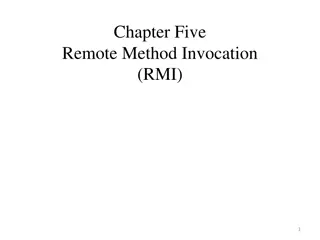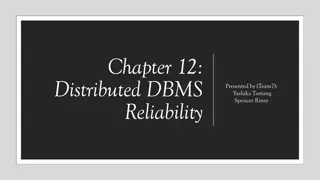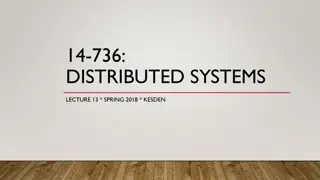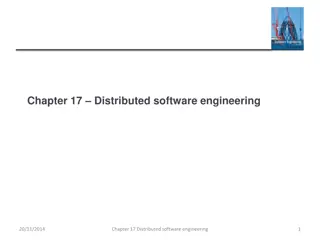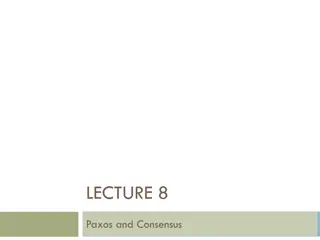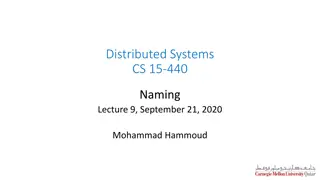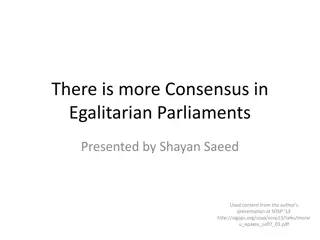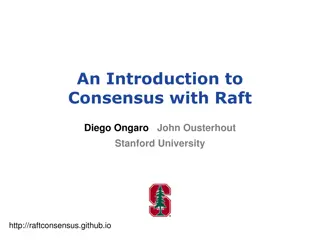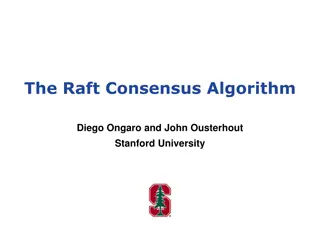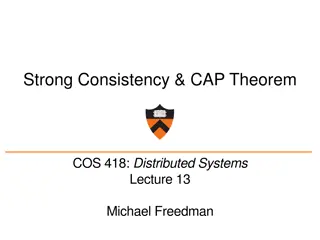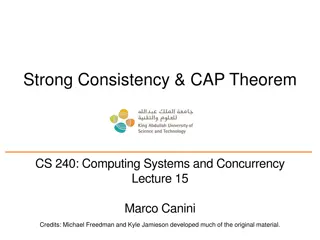
Consensus, Goals, and Assumptions in Paxos Algorithm
Delve into the significance of achieving consensus in distributed systems like blockchain, the safety and liveness properties associated with consensus algorithms, performance metrics to consider, and the assumptions made regarding failures and network models in the context of the Paxos algorithm.
Download Presentation

Please find below an Image/Link to download the presentation.
The content on the website is provided AS IS for your information and personal use only. It may not be sold, licensed, or shared on other websites without obtaining consent from the author. If you encounter any issues during the download, it is possible that the publisher has removed the file from their server.
You are allowed to download the files provided on this website for personal or commercial use, subject to the condition that they are used lawfully. All files are the property of their respective owners.
The content on the website is provided AS IS for your information and personal use only. It may not be sold, licensed, or shared on other websites without obtaining consent from the author.
E N D
Presentation Transcript
Consensus: Paxos Haobin Ni Oct 22, 2018
What is consensus? A group of people go to the same place for the same meal. A set of nodes have the same value for the same variable. X=7 X=7 X=7
Why is it important? In state machine replication (SMR): We need to keep replicas the same = consensus In blockchain: We need to maintain the integrity of global ledger = consensus
What are the goals? Safety properties: Agreement: any two correct nodes decide the same value Validity: any value decided should be a value proposed by some node Liveness properties: Termination: eventually all correct nodes should decide
What are the goals? cont Performance: The number of replicas needed The number of message rounds The total number of messages Overhead (throughput/latency) average/optimistic/etc
What are the assumptions? Failure/adversary model Fault-stop/Crash/Byzantine Limited computational/mining power Rational
What are the assumptions? cont Network model Delay: Synchronous/Partial synchronous/Asynchronous Integrity/Confidentiality: Authenticated channel/Public key infrastructure Clock Topology
The Part-time Parliament 98 Paxos Algorithm Assumes: Crash failure Asynchronous network Achieves: With f faulty nodes: Needs f+1 for safety Needs 2f+1 for liveness 3 message rounds for each decision made
The Part-time Parliament 98 cont Paxos is a Mediterranean island
The Part-time Parliament 98 cont Paxos is a Mediterranean island The Part-time Parliament is a fictional parliamentary system of ancient Paxos where people experience asynchrony and crash failures. Recent archaeological discoveries on the island of Paxos reveal that the parliament functioned despite the peripatetic propensity of its part-time legislators
Leslie Lamport Hey, we ve met before! Time, Clocks, and the Ordering of Events in a Distributed System And we ll meet again! The Byzantine Generals Problem
Leslie Lamport on The Part-time Parliament My attempt at inserting some humor into the subject was a dismal failure I submitted the paper to TOCS in 1990. All three referees said that the paper was mildly interesting, though not very important, but that all the Paxos stuff had to be removed. I was quite annoyed at how humorless everyone working in the field seemed to be, so I did nothing with the paper http://lamport.azurewebsites.net/pubs/pubs.html#lamport-paxos
how humorless everyone working in the field seemed to be Legislators could communicate only by messenger and were provided with funds to hire as many messengers as they needed. A messenger could be counted on not to garble messages, but he might forget that he had already delivered a message, and deliver it again. Like the legislators they served, messengers devoted only part of their time to parliamentary duties. A messenger might leave the Chamber to conduct some business perhaps taking a six-month voyage before delivering a message. He might even leave forever, in which case the message would never be delivered.
how humorless everyone working in the field seemed to be Legislators could communicate only by messenger and were provided with funds to hire as many messengers as they needed. A messenger could be counted on not to garble messages, but he might forget that he had already delivered a message, and deliver it again. Like the legislators they served, messengers devoted only part of their time to parliamentary duties. A messenger might leave the Chamber to conduct some business perhaps taking a six-month voyage before delivering a message. He might even leave forever, in which case the message would never be delivered. We assume the messages could not be changed and an asynchronous network where messages could be duplicated or delayed indefinitely.
Paxos Made Simple 01 The Paxos algorithm, when presented in plain English, is very simple. The description of the algorithm is greatly simplified by deleting all the Paxos stuff and use modern terms. (11pages vs 37pages) But the author is still hand-waving many details (such as leader) and how to implement SMR with Paxos. ...Do not try to implement the algorithm from this paper. Use [parliament] instead.
Paxos Made Moderately Complex 15 Robbert van Renesse and Deniz Altinbuken SMR implemented with a practical version of multi-Paxos. Specified and explained in detail with invariants, pseudocode and a Python implementation.
Disclaimer: I will now try to explain Paxos in a different and maybe very confusing way
Paxos Outline Single-decree synod (Single value consensus) Basic protocol In this talk Leader selection Multi-decree synod Running multiple parallel Single-decree synod protocols Each instance decide one value The decided values are ordered by their instance + optimization + state machine repilication = Moderately complex
Single-decree Synod Run many rounds of 3-phase commit protocol Each round either decides some value or abort Maintains agreement across rounds If a round decides X, all other rounds can only decide X The execution of each instance may interleave each other.
3 Phase Commit -Setting 1 Each round of 3 phase commit will have a node to initiate this round. 2 This node is called the leader of that round. 3 We can make sure each round only have 1 node act as the leader by enforcing different nodes use different round numbers. 4 5 This also defines a total order on all rounds. (with smaller/larger round number). Phase 1: Prepare
3 Phase Commit -Prepare 1 A leader choose a majority/quorum set. 2 Poll that set on what value to propose. It should always propose a value if that value could become the decision. 3 4 The acceptors will abort previous rounds unless it has accepted that round. In this case it informs the leader that value could still become the decision. 5 Phase 1: Prepare
3 Phase Commit -Prepare 1 Leader: We now start round 8. What do you feel like for lunch? 2 Acceptor 1: I have no idea. 3 Acceptor 2: I already accepted Thai in round 6. 4 Acceptor 3: (Never receive this message) 5 Acceptor 1,2: Now we give up all rounds < 8. Phase 1: Prepare
3 Phase Commit -Prepare 1 Leader: We now start round 10. What do you feel like for lunch? 2 Acceptor 1: I have no idea. 3 Acceptor 2: I already accepted Thai in round 6. 4 Acceptor 3: I already accepted Taco in round 7. 5 Acceptor 1,2,3: Now we give up all rounds < 10. Phase 1: Prepare
3 Phase Commit -Propose 1 The leader now propose the latest value some acceptors has accepted to the same majority set. 2 This value gives safety. (we ll explain this later) 3 The acceptors will respond with an accept message unless it has aborted this round. 4 5 Phase 2: Propose
3 Phase Commit -Propose 1 Leader : Let s try agree on Thai in round 6. 2 Acceptor 2: OK. Accept Thai in round 6. Acceptor 3: No I aborted since I m now participating round 10. 3 4 Acceptor 4: (Crashes) 5 Phase 2: Propose
3 Phase Commit -Propose 1 Leader: Let s try agree on Taco in round 10. 2 Acceptor 1: OK. Accept Taco in round 10. Acceptor 2: OK. Accept Taco in round 10. 3 Acceptor 3: OK. Accept Taco in round 10. 4 5 Phase 2: Propose
3 Phase Commit -Learn 1 If all nodes in the majority/quorum set of a round accepted that value, anyone is safe to decide that value. 2 Someone collects the accept messages and shares the information I have seen a round of 3 phase commit succeeds . 3 4 The decision will be the output of a single-decree synod instance. 5 Phase 3: Learn
3 Phase Commit -Learn 1 Leader (learner): I see we have agreed on Taco in round 10. 2 Everyone: Yay, Taco! 3 4 5 Phase 3: Learn
3 Phase Commit -Learn 1 Leader (learner): I see we have agreed on Taco in round 10 and it crashes! 2 Acceptor 1,2,5: Yay, Taco! 3 Acceptor 3,4: ??? 4 But Acceptor 3,4 will learn that decision eventually as all other rounds can now only decide Taco. 5 Phase 3: Learn
Single-decree Synod We now analyze the single-decree synod protocol. Remember our goals: Agreement Validity (trivial) Liveness
Agreement Each round of 3 phase commit either succeeds or aborts. We only need to prove if any round succeeds, then any round with a larger round number either aborts or proposes the same value. Suppose round i succeeds, round j is some round after i.
Agreement cont There must exist a node that belongs to the intersection of two quorums of two rounds. 1 1 2 2 3 3 4 4 5 5
Agreement cont There must exist a node that belongs to the intersection of two quorums of two rounds. For all such nodes, each round it only receives prepare and propose messages and it must have replied both messages of round i for it to succeed. Since i < j, it must receive round j s prepare message after it have accepted in round i. (Otherwise it will abort round i) Now we induct on j.
Agreement cont Base case: j = i + 1 The only possible scenarios (for a node in the intersection) are: Prepare i (OK _ _) Propose i v (Accept i v) Prepare j (Abort) Prepare i (OK _ _) Propose i v (Accept i v) Prepare j (OK i v) In the latter case, round j is either aborted by some other node or has value v since i is the largest round number smaller than j.
Agreement cont 1 1 1 1 Propose (j=i+1, v) OK(i, v) 2 2 2 2 3 3 3 3 4 4 4 4 5 5 5 5 Round j: Propose Round i: Prepare Round i: Propose Round j: Prepare
Agreement cont Induction case: j > i + 1, and all rounds i + 1, , j -1 satisfies the claim. The only possible scenarios are the sane: Prepare i (OK _ _) Propose i v (Accept i v) Prepare j (Abort) Prepare i (OK _ _) Propose i v (Accept i v) Prepare j (OK ? ?) In the latter case, any node in the intersection will only propose a value it has accepted with a round number >= i.
Agreement cont 1 1 1 1 Propose (j, v=round i<=i <j) OK(>i, ?) 2 2 2 2 3 3 3 3 4 4 4 4 5 5 5 5 Round j: Propose Round i: Prepare Round i: Propose Round j: Prepare
Agreement cont Thus round j can only propose a value accepted in round no earlier than i. By our IH, this value can only be v.
Liveness For the single-decree synod to succeed, some round of 3 phase commit must succeed, which requires the leader and the majority of that round to be non- faulty. This gives us the 2f+1 bound. However, even all nodes are non-faulty, we can still make no progress by having 2 conflicting leaders trying to outrun each other:
Liveness cont Leader 1: prepare 1 (Acceptors: OK) Leader 2: prepare 2 (Acceptors: OK, abort 1) Leader 1: propose 1(Acceptors: Aborted) Leader 1: prepare 3 (Acceptors: OK, abort 2) Leader 2: propose 2 (Acceptors: Aborted)
Liveness cont Due to FLP, we cannot prevent the latter scenario from happening if we want the leaders to be fault tolerant as well. One can circumvent this by strengthen the assumptions: physical clocks, fault- detection, randomness etc and use a leader selection sub-protocol.
Conclusion: Paxos Paxos is a consensus protocol that defends against f crash failures with 2f+1 replicas. It is a useful technique to implement state machine replication and has many variants which optimized its different aspects.
CORFU: A Distributed Shared Log Corfu is another Mediterranean island on the North of Paxos By Mahesh Balakrishnan, Dahlia Malkhi, John Davis, Vijayan Prabhakaran, Michael Wei, and Ted Wobber
CORFU: A Distributed Shared Log It is a distributed log designed for high write throughput. (read can scale with the number of replicas) A writer of the log first requests a new write position then write at the position without conflicts. Possible holes due to slow writes/crashes are filled by empty writes.



